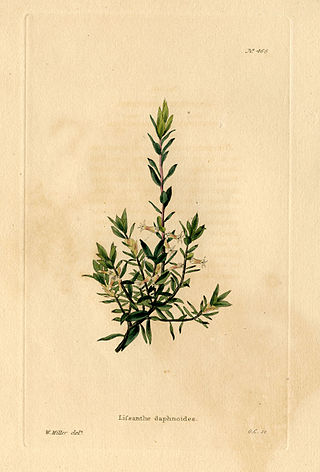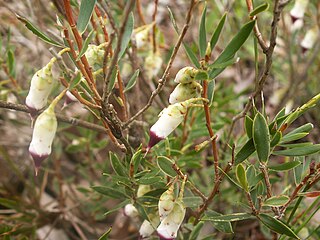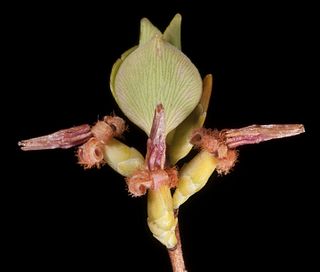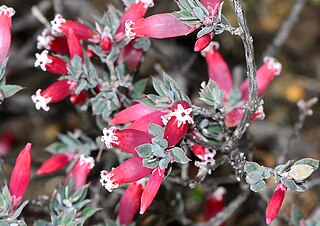
Epacris impressa, also known as common heath, is a plant of the heath family, Ericaceae, that is native to southeast Australia. French botanist Jacques Labillardière collected the species in 1793 and described it in 1805. Four forms have been identified, but no subspecies are recognised. Growing in heathland, shrubland or open forest, it is generally a small shrub around 0.5 to 1 m tall, with small stiff leaves. The red, pink or white tube-like flowers appear from late autumn to early spring. Honeyeater birds, particularly the eastern spinebill, feed upon the nectar of the flowers. It regenerates after bushfire by seed or by resprouting.

The stamen is the pollen-producing reproductive organ of a flower. Collectively the stamens form the androecium.

Leucopogon is a genus of about 150-160 species of shrubs or small trees in the family Ericaceae, in the section of that family formerly treated as the separate family Epacridaceae. They are native to Australia, New Zealand, New Caledonia, the western Pacific Islands and Malaysia, with the greatest species diversity in southeastern Australia. Plants in this genus have leaves with a few more or less parallel veins, and tube-shaped flowers usually with a white beard inside.

Chamelaucium, also known as waxflower, is a genus of shrubs endemic to south western Western Australia. They belong to the myrtle family Myrtaceae and have flowers similar to those of the tea-trees (Leptospermum). The most well-known species is the Geraldton wax, Chamelaucium uncinatum, which is cultivated widely for its large attractive flowers.

Gompholobium, commonly known as glory peas or wedge-peas, is a genus of plants in the pea family Fabaceae and is endemic to Australia. Most species have compound leaves composed of three leaflets and all have ten stamens which are free from each other and a distinctive arrangement of their sepals.

Hypocalymma is a genus of evergreen shrubs in the myrtle family Myrtaceae described as a genus in 1840. The entire genus is endemic to southern Western Australia.

Petrophile is a genus of evergreen shrubs, in the family Proteaceae. The genus is endemic to Australia. Commonly known as conebushes, they typically have prickly, divided foliage and produce prominently-displayed pink, yellow or cream flowers followed by grey, conical fruits.

Hemigenia is a genus of flowering plants in the mint family, Lamiaceae and is endemic to Australia where most species occur in Western Australia, although some are also found in New South Wales and Queensland. Plants in this genus are shrubs or bushes with simple leaves and tube-shaped flowers with the petals forming two "lips" - the upper one with two lobes and the lower one with three.

Brachyloma is a genus of shrubs in the family Ericaceae. The genus is endemic to Australia.

Conostephium pendulum, commonly known as pearl flower, is a small, open shrub in the family Ericaceae endemic to the Swan Coastal Plain from Eneabba to Margaret River.

Stenanthera is a genus of flowering plants in the family Ericaceae. Most are low shrubs with leaves that are paler on the lower surface, tube-shaped flowers and with the fruit a drupe. There are three species, formerly included in the genus Astroloma.

Coleanthera is a plant genus in the family Ericaceae. The genus is endemic to Western Australia, and is currently accepted by Plants of the World online, and the Council of Heads of Australasian Herbaria, but not by the Western Australian Herbarium, where it has been subsumed into the genus, Styphelia, for the phylogenetic reasons given by Darren M. Crayn, Michael Hislop and Caroline Puente-Lelièvre.

Conostephium minus, common name pink-tipped pearl flower, is a species of flowering plant in the family Ericaceae and is endemic to the southwest of Western Australia. It is an erect shrub with linear leaves and white and purplish-pink flowers.

Styphelia stricta is a small plant in the family Ericaceae. It is endemic to Western Australia.
Conostephium marchantiorum is a species of flowering plant in the heath family Ericaceae and is endemic to the south-west of Western Australia. It is an erect shrub with linear leaves clustered near the ends of branchlets, and pale green and pink, densely-bearded, tube-shaped flowers.

Conostephium preissii is a species of flowering plant in the family Ericaceae and is endemic to the southwest of Western Australia. It is an erect shrub with many stems, egg-shaped to oblong leaves and white and purplish to reddish-pink flowers.
Conostephium prolatum is a species of flowering plant in the family Ericaceae and is endemic to the south of Western Australia. It is an erect shrub usually with narrowly egg-shaped or narrowly triangular leaves with the narrower end toward the base, and more or less pendulous, spindle-shaped, cream to straw-coloured and dark purple flowers.
Conostephium roei is a species of flowering plant in the family Ericaceae and is endemic to the southwest of Western Australia. It is an erect shrub with egg-shaped, oblong or linear leaves with and white and purple or reddish brown flowers.
Conostephium uncinatum is a species of flowering plant in the family Ericaceae and is endemic to the southwest of Western Australia. It is an erect shrub with clustered, narrowly oblong leaves with hooked tips, and spindle-shaped flowers.















